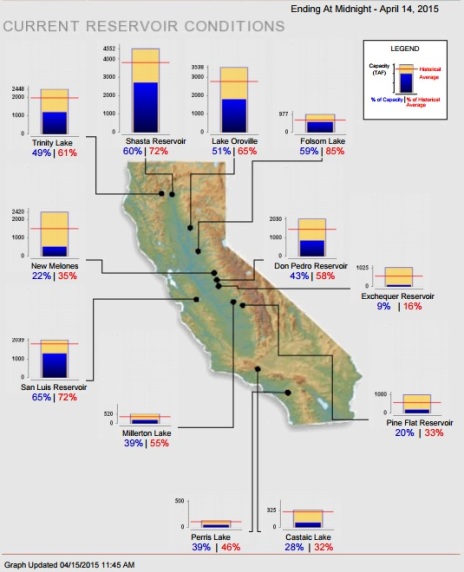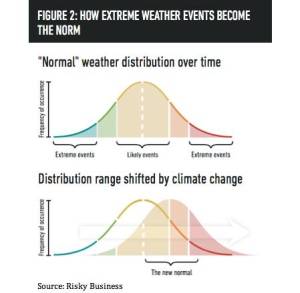Water Conflict Starts as Climate Change Induced California Drought Expected to Worsen Through Summer, Autumn
From
the West Coast perspective, climate change is a day-to-day,
in-your-face affair.
22
April, 2015
The
sunsets in Seattle are tinted red from
massive Siberian permafrost fires belching immense smoke plumes in
springtime.
California snow packs and reservoirs are at historic low levels after
a four-year-long
drought that is the worst in 1200 years and the
hottest winter on record.
The Sunshine State, famous for its Central Valley fruits, vegetables
and wines, is facing increasingly strict water rationing. Other water
intensive industries from resorts, to computer chip makers, to
nonrenewable powerplants are all feeling the pinch.
Off
the coast, a blocking high pressure system — so persistent it has
earned the monicker Ridiculously Resilient Ridge (RRR) from weather
experts — continues to expand. Wildfires for the region are burning
at double their typical rate for Winter and Spring. And the
only real hope for a break in the drought will come this winter with
a potential strong and perhaps even more disruptive El Nino.
Dwindling
Snow Packs and Failing Reservoirs
(Comparison
of California snow packs from water-poor 2014 [left frame] to
water-poorer 2015 [right frame]. Under continued human-forced
warming, snow packs in California may completely disappear during
spring and summer by mid-Century. Image source: LANCE-MODIS.)
But even
if a Monster El Nino does emerge to
hurl a hellacious, storm-engorged Pineapple Express at California
this coming Winter, the state is now facing off against a very water
poor Summer and Autumn. April 20 snow packs have dwindled even from
their amazingly depleted levels last year (see above comparison) and
reservoir levels in many areas are at critical thresholds. At a time
when water pools should be brimming full after winter rains, all
major state water storage sites are well below historical averages as
of April 20 with six out of eleven sites showing levels at less than
39 percent capacity. Exchequer Reservoir, in southern Central Valley,
is the driest of a dry bunch — showing a 9 percent capacity.
These
low levels come after major consumption reduction policies were put
in place by Governor Brown and by numerous municipalities during
2014. Now, critical State water levels are resulting in additional
reductions in urban water use of 25 percent statewide. A
policy that is causing backlash from the wealthy, businesses,
landowners, and other high-volume consumers together
with calls for new desalination plants and pipelines to divert
Seattle water into Lake Mead (a project that, by itself, would cost
about 30 billion dollars). There water levels have gone through a
multi-decade free-fall and
Monday hit a new, all time, record low level of 1081.10 feet.
(Current
California reservoir situation map. Image source: The
Pacific Institute’s California Drought Page.)
Drought
to Worsen at Least Through Autumn
Long-range
forecasts through mid-summer show continued extreme dry conditions on
tap.The
US Seasonal Drought Outlook shows
drought worsening through July 31st for a six state section of the US
Southwest. A section of increased and record drying which features
California at center mass. For this region, strong south-to-north air
flows beneath an expanding heat dome will continue to bring much
hotter and drier than normal conditions. The heat dome will continue
to feed on much hotter Northeastern Pacific water temperatures in the
range of +3 to +5 warmer than normal. (A
pool of hot water that is also implicated in various ocean creature
mass die-offs over the past two years.)
With
California already facing the hottest and driest conditions in two
millenia, a continuation and intensification of historic heat and
drought may well be seen as merciless. And what it means is imminent
water shortages and likely conflict over a dwindling supply.
(The US
Seasonal Drought Outlook provided
by NOAA’s Climate Prediction Center shows the ongoing 1200 year
California Drought intensifying through at least mid-July.)
Already,
businesses are up in arms over a ratcheting water use reduction
policy. According
to reports from the Los Angeles Times,
farmers looking at water reductions in the range of 25 to 30 percent
are questioning whether they can continue to produce. Water brokers
to desert resorts in Coachella Valley are looking at losses exceeding
10 million dollars. Landscaping, intended to add to home values, is
withering, drying up investments and home equity in one blow.
These
deep cuts are rippling on down the line to threaten a wide variety of
businesses, all dependent on water access. Business policy advocate
Valerie Nera noted to the Times:
“Beverage manufacturers, bottlers, coffee shops, industries like micro chip processors and food processors for example would be put in jeopardy if 25 percent of their water usage were cut or if they had to pay significantly more for their water.”
All
losses that will mount on top of an estimated 2.2
billion dollars in damages from the drought’s impact in 2014 alone.
Losses that will, all too likely, continue into 2016 if a potential,
very strong, El Nino doesn’t develop and deliver very heavy rains.
A
Crisis Without End
But
the issue isn’t just one of water impacts for this year and the
possible impacts for next. It is an issue of ongoing and worsening
water impacts throughout this Century. Impacts set off by an
inexorable and ramping of human-caused climate change and highlighted
in a new report earlier this month entitled: Risky
Business — The Economic Risks of Climate Change in the United
States.
(Instances
of extreme weather become ‘normal’ as global temperatures
increase. Graph from the Risky
Business climate
report.)
In
short, for California, it’s not just an issue of making it through
this drought. It’s an issue of making it through the many that will
surely follow — decade after decade after decade. Making it through
the more intense storms that will break droughts by delivering far
more rain in a far shorter time than previously experienced. An issue
of dealing with a diminishment and then a loss of snowpack. An issue
of dealing with significant property losses from rising sea levels.
An issue of dealing with harm to almost every food-producing sector
from farming, through drought and increased storm intensity, to
fishing, through a major blow to ocean health and vitality.
In
such an instance we can read the words Climate Change writ large in
the current California drought emergency. Not just because it is the
worst drought to affect the state in two millenia. Not just because
conflict over water resources is starting to ramp up now. But also
because the current crisis is but one in a long succession of similar
and worsening disruptions that will surely follow. The terrible
result of a ramping heating of the atmosphere set off by human
greenhouse gas emissions.
Links:
Hat
Tip to Colorado Bob
Hat
Tip to Andy in San Diego
Hat
Tip to DTLange








No comments:
Post a Comment
Note: only a member of this blog may post a comment.